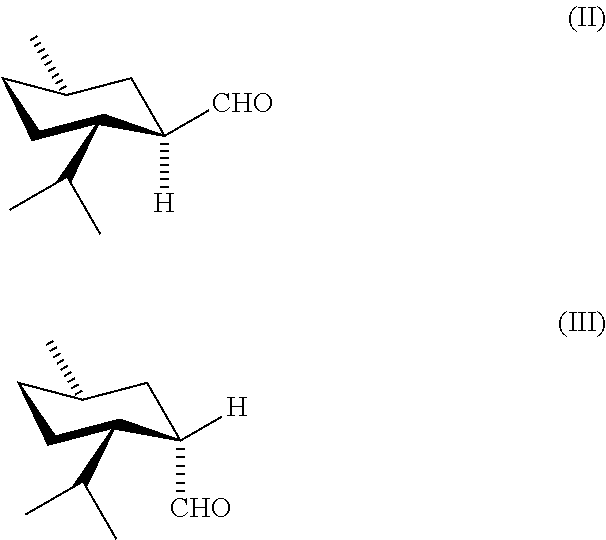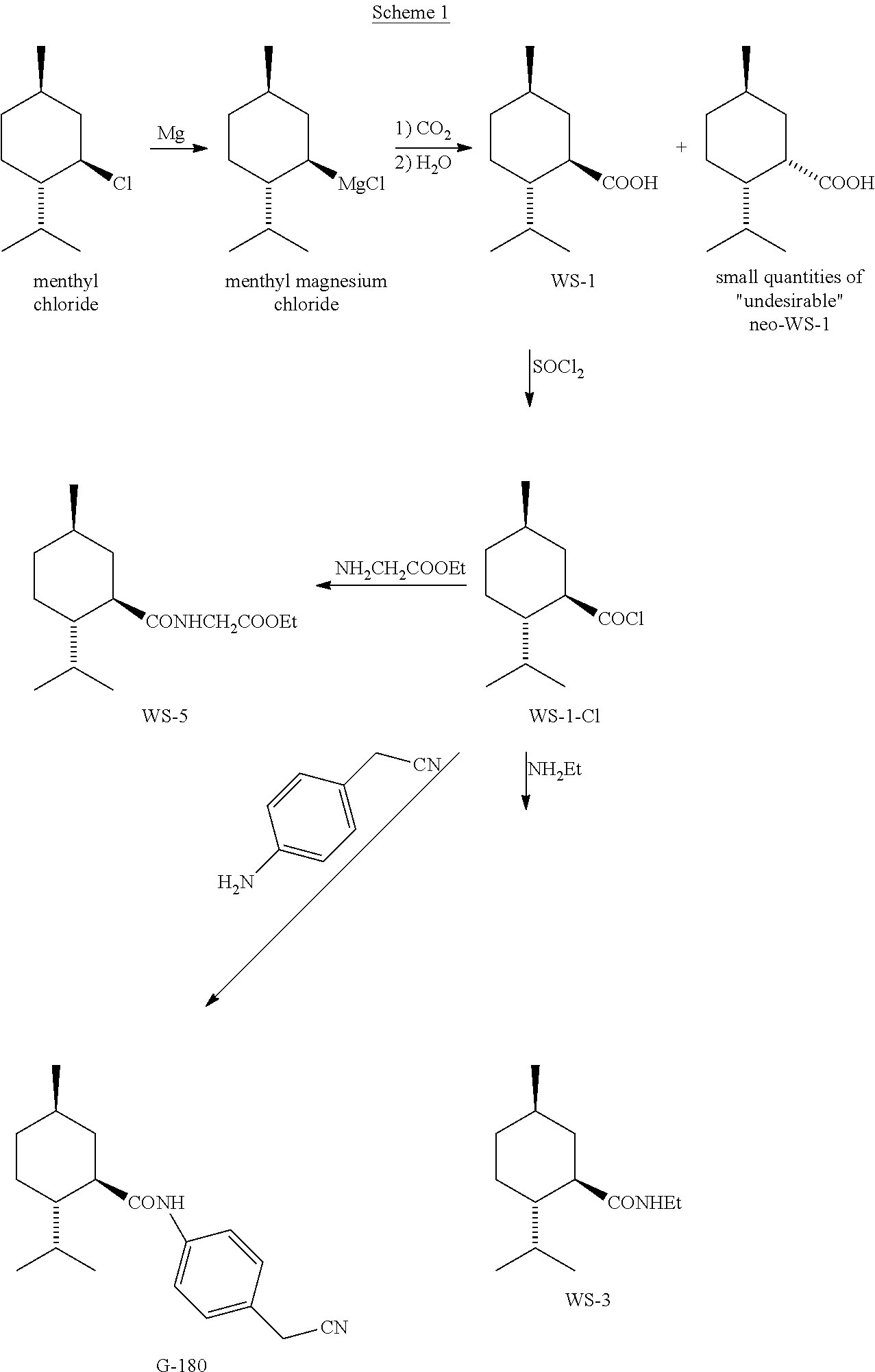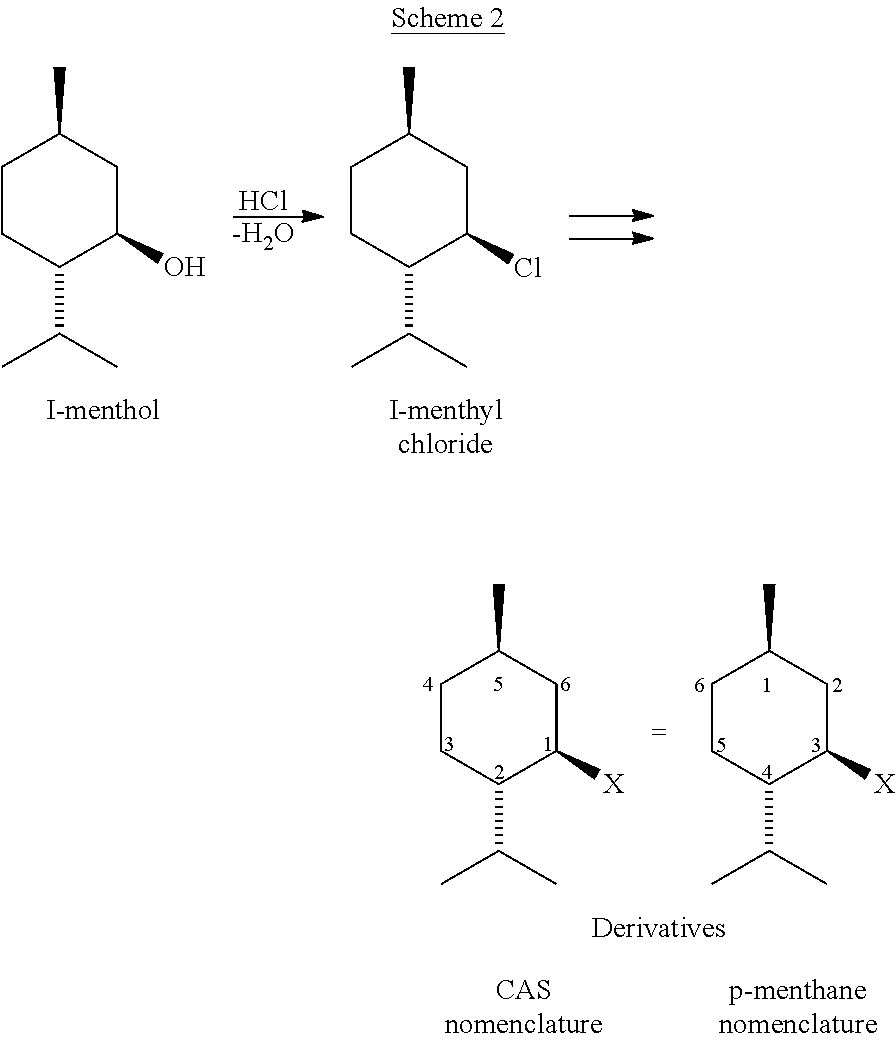PROCESS FOR MAKING NEO-ENRICHED p-MENTHANE COMPOUNDS
a pmenthane and nitrile technology, applied in the preparation of carboxylic compounds, heterocyclic compounds, carbonyl compounds, etc., can solve the problems of unattractive synthetic approaches, failure to give experimental details, literature data, examples, etc., and achieve the effect of reducing the number of oxidized compounds
- Summary
- Abstract
- Description
- Claims
- Application Information
AI Technical Summary
Benefits of technology
Problems solved by technology
Method used
Image
Examples
example a
Preparation of Oxaspiro Compound (I)
[0036]The procedure of Duran et al. (Tetrahedron: Asymmetry 14 (2003) 2529) is generally followed. Thus, a 5000-mL, 3-neck flask with N2 purge and mechanical stirrer is charged with sodium hydride (60% in mineral oil, 50.5 g) and anhydrous dimethylsulfoxide (800 mL). Trimethyl sulfoxonium iodide (231 g, 1.05 mol) is added and the mixture is stirred at room temperature for 3 h. The flask is then placed in an ice bath, cooling the flask to 6° C. A mixture of 83.5% 1-menthone / 16.5% d-isomenthone (192 mL, 171 g, product of Symrise) is added over 19 min. by addition funnel. Following the addition, the flask temperature is 8° C. The ice bath is removed and the flask is allowed to warm to room temperature. The flask is wrapped in foil to protect the reaction from light. After stirring for 20 h, an analyzed sample shows 13.8% menthone remaining and 82.4% of oxaspiro product formed. The flask is cooled to 5° C., and the flask contents are carefully quenche...
examples 1-8
Lewis Acid-Catalyzed Rearrangement of Oxaspiro Compound (I) to WS-1 Aldehydes
[0037]Lewis acid (5.0 mmol) is added to a solution of oxaspiro intermediate (0.2 mol) in heptane (100 mL), except for Example 2, where methyl tert-butyl ether is the solvent. The mixture is stirred for the time and at the temperature indicated in Table 1 until complete or almost complete (≦2%) disappearance of oxaspiro intermediate. Lewis acids, GC yields of WS-1 aldehydes, and ratios of neo:normal isomers are shown in Table 1.
TABLE 1Temp.,ReactionTotal GCRatioEx.Lewis acid° C.time, hyield, %*neo:normal1ZnBr21014.262.42.442ZnBr2583021.82.403ZnCl2804.048.51.064ZnCl21012.543.33.115FeCl31015.533.22.356SnCl41016.023.72.187LiClO41017.215.62.008BF3•Et2O0 to −22.05.21.95*Not optimized; excludes the solvent component.
example 9
Neo Isomer-Enriched WS-1 and WS-1 Acid Chloride
[0038]Crude WS-1 aldehydes. Oxaspiro compound (I) (40.0 g, 0.238 mol) is added dropwise over 15 min, to a stirred refluxing (102° C.) solution of ZnBr2 (1.0 g, 0.004 mol) in heptane (230 mL), and the mixture is refluxed and periodically analyzed by GC until the concentration of the oxaspiro intermediate drops below 1% (about 6 h). The reaction is repeated four times, and the products of all five reactions are combined to give a crude mixture (1005 g total) containing by GC 12.46% (124.2 g, 0.74 mol) of WS-1 aldehyde isomers with a neo:normal ratio ˜2.3. Yield from (I): 62.2%.
[0039]Oxidation to crude WS-1 acids. Air is passed using a ceramic frit bubbler through the stirred crude aldehyde solution (obtained in the previous section) at ambient temperature over 33 h. During the reaction, the solvent (heptane) is maintained in the solution with a dry-ice condenser to supplement a regular condenser with chilled water. The resulting product (...
PUM
| Property | Measurement | Unit |
|---|---|---|
| molar ratio | aaaaa | aaaaa |
| temperatures | aaaaa | aaaaa |
| temperature | aaaaa | aaaaa |
Abstract
Description
Claims
Application Information
 Login to View More
Login to View More - R&D
- Intellectual Property
- Life Sciences
- Materials
- Tech Scout
- Unparalleled Data Quality
- Higher Quality Content
- 60% Fewer Hallucinations
Browse by: Latest US Patents, China's latest patents, Technical Efficacy Thesaurus, Application Domain, Technology Topic, Popular Technical Reports.
© 2025 PatSnap. All rights reserved.Legal|Privacy policy|Modern Slavery Act Transparency Statement|Sitemap|About US| Contact US: help@patsnap.com



